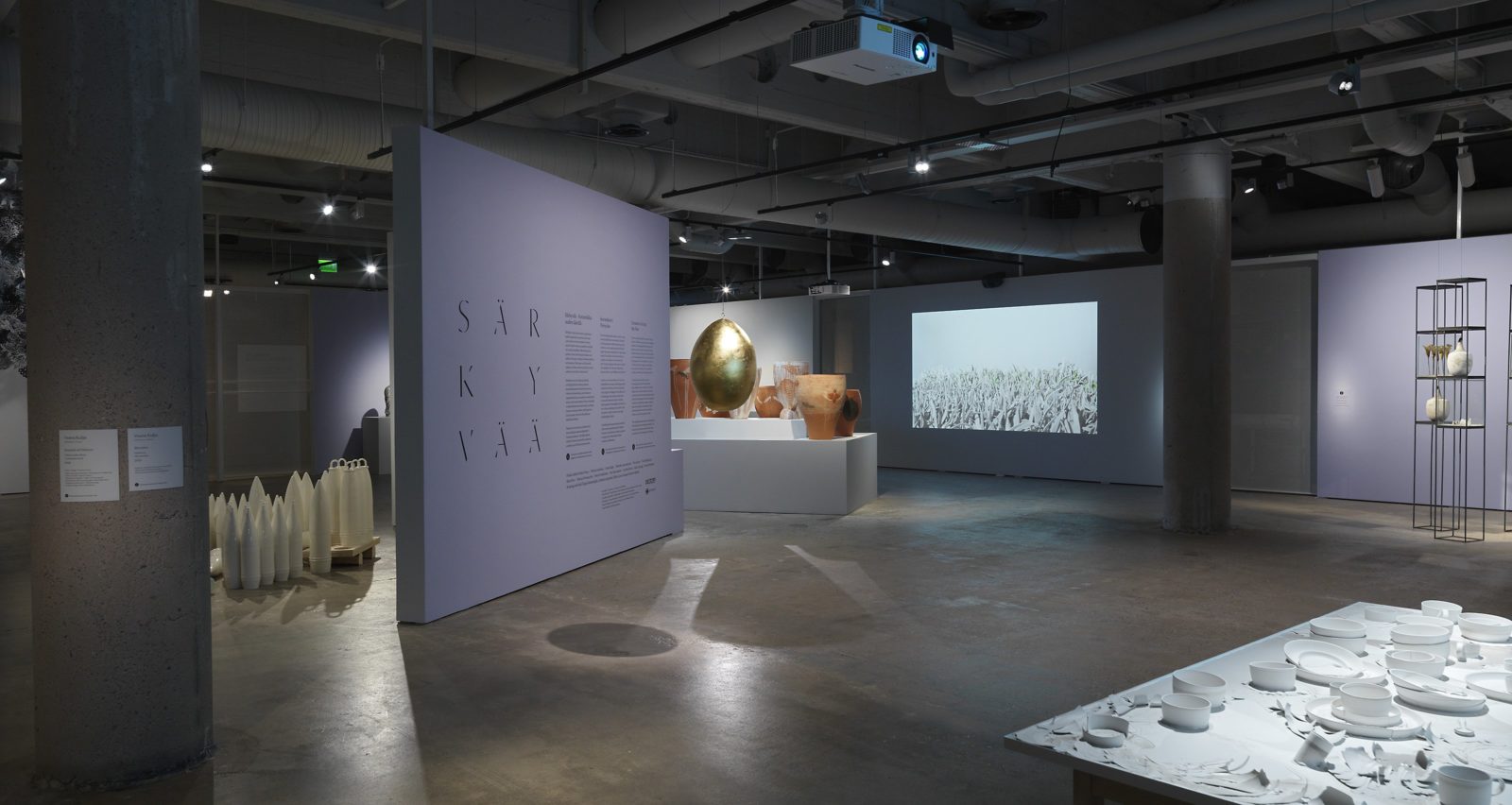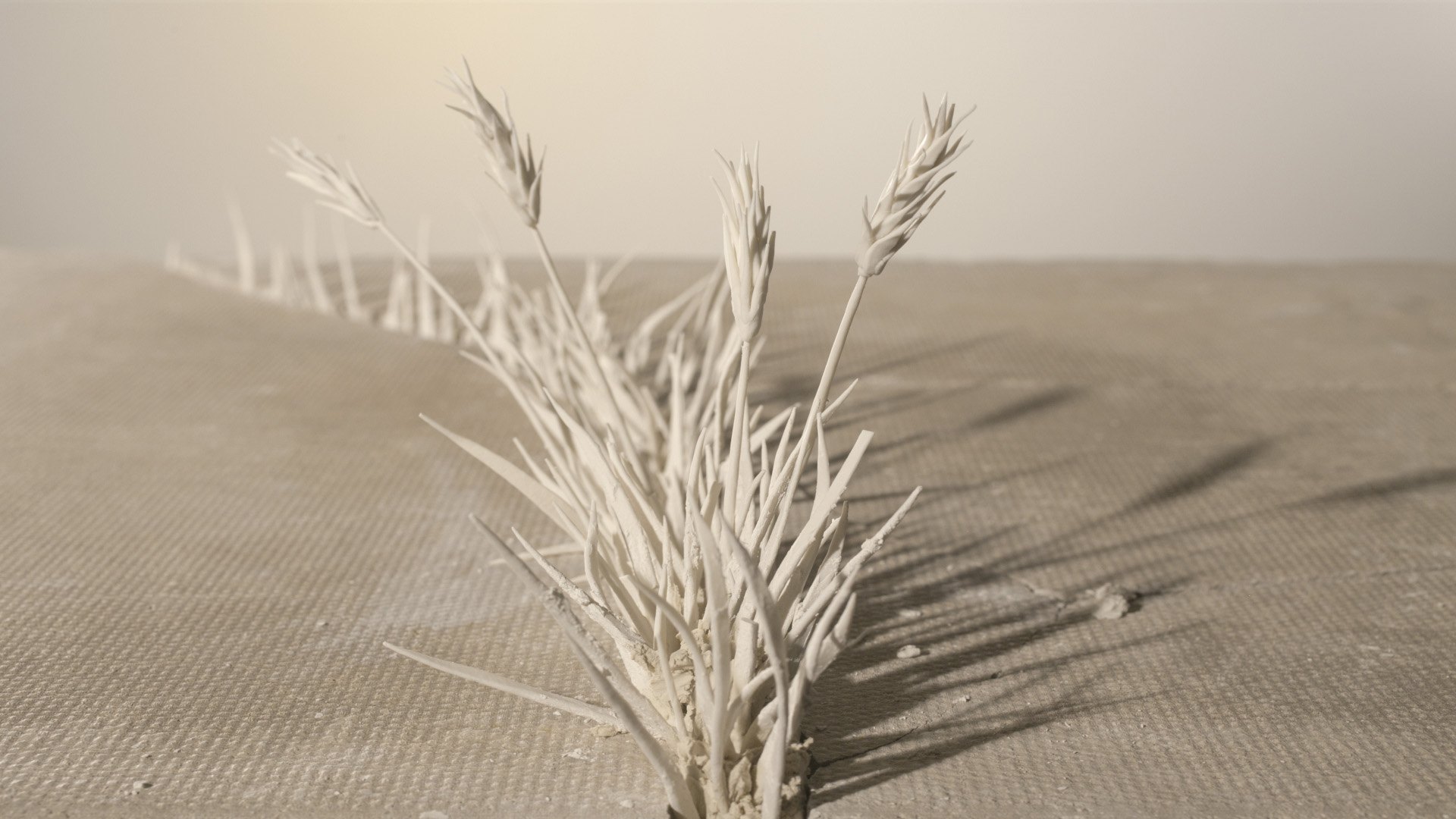
What sounds do ceramics make, Veera Kulju?
EMMA’s new exhibition settles in the juncture of contemporary art and design, exploring the themes of decay and reconstruction through ceramic art. The Ceramics Facing the New exhibition addresses the special relationship between clay and humanity, interpreting today’s world characterised by environmental concern and the disintegration of social structures. Weekly met with ceramic artist Veera Kulju who has two works in the exhibition: Sounds of Silence (2018) and Become (2021).

Ceramic art has gained popularity during recent years, and the trend has penetrated contemporary art. The Ceramics Facing the New exhibition presents twelve artists and two artist groups specialized in ceramics. Sensitive to current topics, the works feature unconventional use of materials and techniques.
Weekly: Veera Kulju, your work Sounds of Silence is a video about listening to forest sounds. Moving indoors, we see a dancer in a jingly outfit decorated with pieces of porcelain and keys. How did you come up with a composition of ceramics, dance and sounds?
Veera Kulju: Working on the keys theme, I noticed that many keys together make a really beautiful sound. I wanted to utilize this sound as part of my series of works. Because the meaning of the work is in the sound, video format soon became an obvious choice. Rhythm and movement are important to me. Moreover, I wanted to cooperate with various artists who interpret things differently compared with my own way of doing. I wanted to provide freedom of expression in cooperation with others. For dancer Satu Halttunen, my only instruction was to try and move in the outfit without making any sound. That adheres to the theme of becoming visible. Living in the current world, we cannot be completely silent; we are each responsible for our own resonance in this universe. By the way, the video was shot chronologically; video artist Ananya Tanttu went to the forest in the morning with her camera. After that we shot the dance scene, and in the evening, Ananya was back in the forest. The entire process followed a truly organic rhythm.
W: Rather traditional ways and forms are favoured in ceramics. It seems that at the moment, all innovation in the field is technical, as painting, glazing and firing techniques are developing. The exhibition is described to present ceramics facing new, and the objective was “to do things differently”. “The need to challenge the traditional ways drives people to seek more ecological methods, to use new techniques, and extend their works to occupy the presentation space.”
VK: Exhibition curator Laura Kokkonen of EMMA wanted to include my video in the exhibition, and I assume she was interested in using sound with ceramics. I also address the fleeting nature of natural resources through the fragility of clay. I feel that I am an explorer and beginner with clay. I really appreciate artists who master their materials. To me, clay is a medium of expression, and an uncontrolled one. The use of video helps reach a wide audience, through various media, and shows new sides of working with ceramics.
W: Firing sounds like a wild and unpredictable work phase. The description of the exhibition mentions that potters used to be highly respected, feared even.
VK: Uncontrollability is one reason why I work with ceramics. To me, nothing can “be broken” in that process. However, I do understand that people seek control; I seek to escape it. Clay is an emotional material to me. I seek to involve certain freedom and uncontrollability in my work. Cleanness and sincerity. Some ask about the works breaking or being broken, and it is an interesting theme regarding nature, for example, its change cycle and breaking. In fact, one of my works just recently split into two in the middle. I need to desensitize myself in a way, put the work in the kiln and see what comes out. In a way I would like to delve in materials and glazes, but I tend to delve too deep in the details. I seek to involve certain freedom and uncontrollability in my work. Cleanness and sincerity. Clay is like nature, its perfection is born from uncontrollability and the surprise element – I don’t want to control the material but let it live. Of course there are some rules. For example, it is absolutely necessary to design the structures. Yet, my work is all about experimentation. It is my way to exist, to understand myself and others.
W: In the exhibition description, it says that ceramics are both ancient and contemporary, a technique that is aggressively reforming, and a good example of the constant and transformational power of art. What will you be working on next?
VK: I’m getting started on my grant (Finnish Cultural Foundation) so I’m free to do artistic work. Tomorrow I’ll open the kiln that has been cooling overnight and start building a forest for the summer exhibition in Nastola to open on the 12th of June. After that I’ll clear out my calendar and focus on building my solo exhibition for Galleria Halmetoja in the spring of 2022 and to develop my cooperation with my New York gallerist Hostler Burrows. This will involve co-working, new encounters, courage, and as always, curiosity.

The Ceramics Facing the New exhibition is produced in collaboration with Ornamo Art and Design Finland. The featured artists were selected in an open portfolio call to the members of Ornamo. The need to challenge the traditional ways of making drives people to seek more ecological methods, use new techniques, and extend their works to occupy the presentation space. Content-wise, the works address environmental destruction and species extinction, conflicts and their consequences, impermanence and loneliness, but also nature’s vitality, discovering a connection, and presence.

Other exhibited works include three animations by British artist Katie Spragg. Spragg’s works recall the wonder and joy of nature observation. Meri Oivo’s large installation Fragile also refers to natural formations: fungal mycelium, twigs and corals. The work consists of several fragile pieces of porcelain that Oivo has created using her own casting and handicraft method. The exhibition also includes an artistic research project by the Working with Soil team, exploring the Espoo soil to study the changes caused by natural phenomena and human activity. Changes in land surfaces is the focus in Matteo Pennacchio’s series of ceramic reliefs entitled Marks. Nathalie Lautenbacher finished the work Recovery at EMMA’s exhibition hall. On display is an unprecedented body of work, a selection of unfired versions of familiar dishes. The work deals with the inevitability of decomposition and the circulation of matter in natural processes.

The artists taking part in the Ceramics Facing the New exhibition are Priska Falin & Helen Felcey, Veera Kulju, Nathalie Lautenbacher, Piia Lieste, Matias Karsikas, Tiia Matikainen, Meri Oivo, Matteo Pennacchio, Maria Punkkinen, Outi Savolainen, Caroline Slotte, Katie Spragg, Irma Weckman and the group Working with Soil (Özgü Gündeşlioğlu, Catharina Kajander, Riikka Latva-Somppi and Maarit Mäkelä). The exhibition takes place at the Bryk & Wirkkala Visible Storage that presents the lifeworks by Rut Bryk and Tapio Wirkkala. EMMA’s theme for 2021 is the power of art.

The extensive mobile guide to the exhibition features background information and interview videos. Ceramics Facing the New exhibition at EMMA from 3 May 2021 to 28 August 2022. For tickets and more information, please visit here.
This post was done in collaboration with EMMA Museum, but all thoughts and editorial content are our own. Like everything at Weekly, our partner content is carefully curated to make sure it’s relevant to our readers.